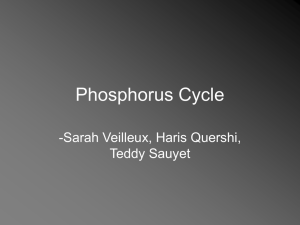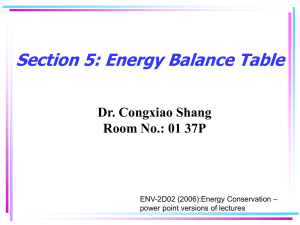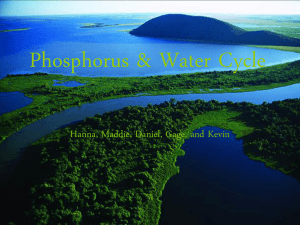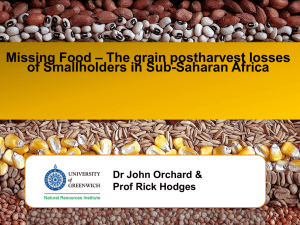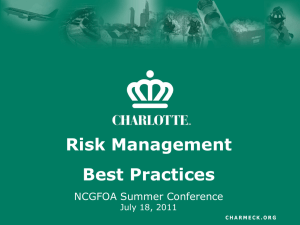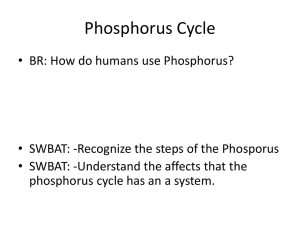Field school Training Phosphorus use efficiency in dairy production
advertisement
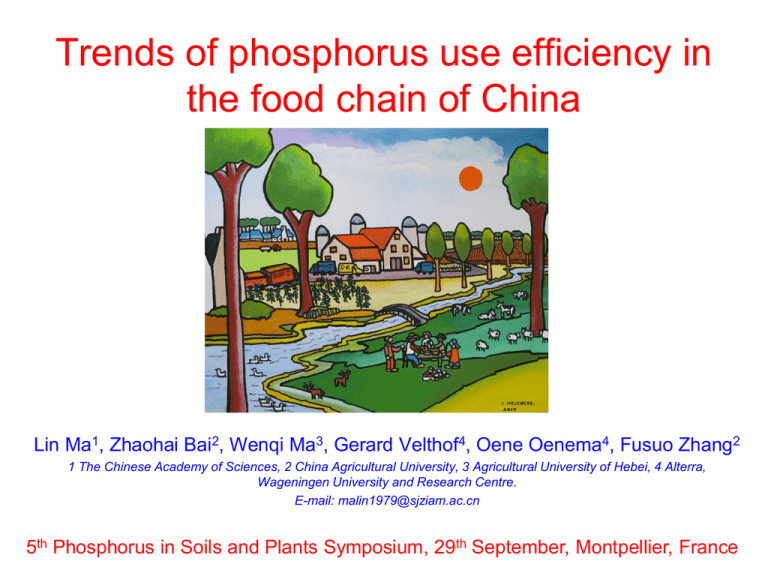
Trends of phosphorus use efficiency in the food chain of China Lin Ma1, Zhaohai Bai2, Wenqi Ma3, Gerard Velthof4, Oene Oenema4, Fusuo Zhang2 1 The Chinese Academy of Sciences, 2 China Agricultural University, 3 Agricultural University of Hebei, 4 Alterra, Wageningen University and Research Centre. E-mail: malin1979@sjziam.ac.cn 5th Phosphorus in Soils and Plants Symposium, 29th September, Montpellier, France Outline 1. Why study phosphorus (P) use efficiency in the food chain of China? 2. Definitions of phosphorus use efficiency (PUE) 3. Changes of PUE in the food chain of China 4. Options of sustainable P use in the food chain Why study PUE in the food chain of China? Question: Is it a sustainable food system? Changes relative to 1961, % 900 800 Cereals yield per agriculture land Livestock density 700 Changes relative to 1961, % 8000 Cereals yield per agriculture land 7000 Fertilizer consumption 6000 600 5000 500 3000 200 2000 100 1000 0 0 1961 1964 1967 1970 1973 1976 1979 1982 1985 1988 1991 1994 1997 2000 2003 2006 2009 300 Year 1961 1964 1967 1970 1973 1976 1979 1982 1985 1988 1991 1994 1997 2000 2003 2006 2009 4000 400 Year FAO database NUFER model (NUtrient flows in Food chains, Environment and Resources use) Atmosphere N2, NH3, N2O Human consumption Exports and losses Food processing imports Animal production Crop production (soil accumulation) Erosion and runoff • Regional and national scale of China • 1950-2010, and 2030 • 18 main crops • 11 animal categories • Households in rural and urban N Leaching Groundwater P Surface waters (Ma et al., JEQ 2010) Indicators of nutrient use efficiency • P cost of food (kg/kg) • PUEf - Phosphorus use efficiency in the food chain, % • PUEc - Phosphorus use efficiency in crop production, % • PUEa - Phosphorus use efficiency in animal production, % (Ma et al., JEQ 2010) P flows in food chain in China P P 1980 2005 Households 0 exports 0.2 (20%) losses 0.4 0 1.6 (100%) Imports 0.3 (19%) 0 0 exports 0.5 1.3 (81%) 0.2 0.6 (37%) 0.1 (10%) losses exports Exports /losses Animal production 0.5 0 0.2 Crop production (soil) Accumulation in soil 0 0 0.1exports 0.9 0.5 0.3 (10%) losses 0.6 Food processing 0.2 0.1 exports Households 0.6 (60%) losses 0.5 exports 1.0 (63%) losses 0.1 (10%) losses 0.5exports Food processing 1.4 (18%) exports 0.2 (9%) losses 1.5 1.1 7.8 (100%) 1.3 2.6 (33%) Exports /losses 0 0 exports Animal production Imports 1.0 5.2 (67%) 0.3 1.7 0 0.2 Crop production (soil) 2.1 (70%) losses 0.8 exports 3.0 (38%) losses 0.4 (11%) losses Accumulation in soil 3.4 (44%) • Total P input was 5 times larger in 2005 than in 1980; • P cost of food production was 4 kg/kg in1980 and 13 kg/kg in 2005. (Ma et al., 2012) PUE in the food chain of Chian 100 PUEc PUEa PUEf 80 USA and NL 60 PUEc = ~ 60% 40 PUEa = ~ 35% 20 0 1950 PUEf = ~ 20% 1960 1970 1980 1990 2000 2010 Note: PUE= (O Main product / I Total)*100,Phosphorus use efficiency. PUEc, PUEa and PUEf are the PUE in crop production, animal production and food chain. (Ma et al., Unpublished data, Smit et al., 2010 and Suh et al., 2011 ) P flux increased dramatically in the food chain of China P flow (10000 ton) 1600 1400 1200 Household Food processing Animal production Cropland production 1000 800 600 400 200 0 1950 1955 1960 1965 1970 1975 1980 1985 1990 1995 2000 2005 2010 Year (Ma et al., Unpublished data) 1950 1952 1954 1956 1958 1960 1962 1964 1966 1968 1970 1972 1974 1976 1978 1980 1982 1984 1986 1988 1990 1992 1994 1996 1998 2000 2002 2004 2006 2008 2010 P cycling rate decreased in the food chain of China Recycled P New P 100% 80% 60% 40% 20% 0% (Ma et al., Unpublished data) P losses in food chain in China 1980 1950 15% Crop production Animal production 0% 2010 12% 19% 30% 38% 9% 7% Food processing Household 47% 66% 44% P losses (104 ton) Percentage of P losses from sub-systems 350 300 250 200 150 100 50 0 1950 13% Household Food processing Animal production Crop production 1960 1970 (Ma et al., Unpublished data) 1980 Year 1990 2000 2010 Options of sustainable P use in the food chain 1. Improving PUE in crop production 2. Improving PUE in animal production 3. Recycling wastes from the whole chain P cost in the food chain (kg/kg) 4. Lowering human consumption of animal products Ma et al., EST 2013 1980 2005 2030 Year Double High Technology: from technology to farmers’ practices ----Increase yield and PUE by 30-50% Field school Training (Chen et al., PNAS, 2011) Improving PUE in animal production Phosphorus use efficiency % Phosphorus use efficiency in dairy production in China 40 30 20 10 0 Traditional Grassland-based Animal Collective Industrial Herd Average System Animal: Milking dairy; Herd, including milking dairy, calves and heifers; System, crop-dairy production chain PUE at herd level is 25-35% in EU and USA. Bai et al., JEQ 2013 Recycling wastes from the whole chain P footprint of China’s pig production in 2010 By-product + Import 987 New Applied 792 911 Crop Feed 227 1511 Pig gain Carcass Pork 79 394 Consumed 38 43 283 119 14 53 631 329 558 Field loss P not taken Manure loss Manure export 32 22 Slaughter Processing waste waste 5 Food waste Bai et al., EST 2014 25 20 1961 1963 1965 1967 1969 1971 1973 1975 1977 1979 1981 1983 1985 1987 1989 1991 1993 1995 1997 1999 2001 2003 2005 2007 Food protein supply quantity (kg/capita/year) Lowering human consumption of animal products 30 animal food plant food The Chinese food dietary guidelines 15 10 5 0 Year (Ma et al., JEQ 2013) Regional variations in P management P losses from crop production and animal production (Ma L. et al., STOTEN 2012) Summary • Food P cost increased dramatically in the past several decades in China, following with low PUE and high P losses. • Optimizing diets and implementation of integrated nutrient management would decrease P losses, and would greatly increase PUE in the whole food chain. Atmosphere N2, NH3, N2O • A food chain approach is really needed to improve sustainable P management in the food systems. Human consumption Exports and losses Food processing imports Animal production Crop production (soil accumulation) Erosion and runoff N Leaching Groundwater P Surface waters Some main publications • Ma L., Wang F. H., Zhang W. F., Ma, W. Q., Velthof G.L., Qin W., Oenema O., Zhang F.S., Environmental assessment of nutrient management options for the food chain of China. Environmental Science & Technology, 2013, 47 (13), 7260-7268. • Ma L., Zhang W. F., Ma W.Q., Velthof G.L., Oenema O., Zhang F.S., An analysis of developments and challenges in nutrient management in China. Journal of Environmental Quality, 2013, 42 (4): 951-961. • Bai Z.H., Ma L., Oenema O., Chen Q., Zhang F.S., Nitrogen and phosphorus use efficiencies in dairy production in China. Journal of Environmental Quality, 2013, 42 (4): 990-1001. • Hou Y., Ma L., Gao Z. L., Wang F. H., Sims J. T., Ma W. Q., Zhang F. S., Nitrogen and phosphorus flows and losses in the food chain in China, 1980-2010. Journal of Environmental Quality 2013, 42 (4): 962-971. • Ma, L. G. L. Velthof, F. H. Wang, Z. Liu, Y. Zhang, J. Wei, J. P. Lesschen, W. Q. Ma, O. Oenema, F. S. Zhang et al.(2012) Nitrogen and phosphorus use efficiencies and losses in the food chain in China at regional scales in 1980 and 2005. Science of the Total Environment 2012, 434: 51-61. • W.Q Ma, Ma L., Li J. H. et al., Phosphorus flows and use efficiencies in production and consumption of wheat, rice, and maize in China, Chemosphere, 2011, 84(6): 814-821. • F. Wang, J.T. Sims, Ma L., W. Ma, Z. Dou, and F. Zhang, The Phosphorus Footprint of China’s Food Chain: Implications for Food Security, Natural Resource Management, and Environmental Quality, JEQ, 2011, 40(4): 1081-1089. • Ma L., W.Q. Ma, G.L. Velthof et al,. Modeling Nutrient Flows in the Food Chain of China, Journal of Environmental Quality, 2010, 39(4): 1279-1289. • Bai Z.H., Ma L., Qin W., Oenema O., Chen Q., Zhang F.S., Changes in Pig Production in China and Their Effects on Nitrogen and Phosphorus Use and Losses. Environmental Science & Technology, 2014 (Minor revision) Thanks for your attention! Our food pyramid in the future 5th Phosphorus in Soils and Plants Symposium, 29th September, Montpellier, France

